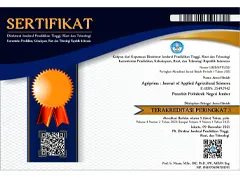Respon Perlakuan Asam Jasmonat, Asam Salisilat dan Kitosan terhadap Produksi Metabolit Sekunder pada Kalus Padi Daun Berpigmen
DOI:
10.25047/agriprima.v8i1.599Downloads
Abstract
Padi Black Madras (Oryza sativa L.) merupakan padi hias yang selain biasa digunakan sebagai ornamen, juga dapat digunakan sebagai sumber pharmaceutical yang bermanfaat bagi kesehatan manusia. Namun saat ini belum banyak diketahui potensialnya menjadi sumber pharmaceutical seperti metabolit sekunder. Metabolit sekunder yang dihasilkan oleh padi black madras ini dapat diambil melalui kultur jaringan dengan cara elisitasi. Penelitian ini dilakukan untuk mengetahui respon kalus padi dan produksi metabolit sekunder pada padi Black Madras terhadap pemberian asam jasmonat, asam salisilat, dan kitosan. Hasil penelitian ini menunjukkan pemberian elisitor memberikan respon pada kalus padi dan produksi metabolit sekunder padi black madras terhadap pemberian asam jasmonat, asam salisilat, dan kitosan. Varietas terbaik didapatkan pada varietas IR64 sebagai kontrol daripada Black madras dengan perlakuan dengan kandungan fenolik (0,1548 mg GAE/g) dan flavonoid (0,2830 mg QE/g) terbaik ada pada media dengan pemberian Asam Jasmonat 10ppm. Sedangkan pada antosianin dengan pemberian yang terbaik adalah Kitosan 50ppm (PC: 2,852 CV/g FW dan PP: 0,538 CV/ test tube). Varietas Black madras lebih cenderung dalam peningkatan biomassa dengan kandungan fenolik (0,1165 mg GAE/g) dan flavonoid (0,2107 mg QE/g) pada perlakuan kontrol meskipun dalam produksi antosianin cukup tinggi dengan Kitosan 50ppm (PC: 2,832 CV/g FW) dan Asam Salisilat 10ppm (PP: 0,440 CV/ test tube) lebih daripada perlakuan kontrol.
Keywords:
Elisitasi Kultur Jaringan Metabolit Sekunder PadiReferences
Anusha, T. S., Joseph, M. V., & Elyas, K. K. (2016). Callus Induction and Elicitation of Total Phenolics in Callus Cell Suspension Culture of Celastrus paniculatus- wild, and Endangered Medicinal Plant in India. Pharmacogn, 8(5):471-475.
Ariati, S. N., Waeniati, Muslimin, dan I. N. Suwastika. (2012). Induksi kalus tanaman kakao (Theobroma cacao L.) pada media MS dengan penambahan 2,4-D, BAP dan air kelapa. Jurnal Natural Science. 1(1):74-84.
Azizati, Z. (2019). Pembuatan dan Karakterisasi Kitosan Kulit Udang Galah. Walisongo Journal of Chemistry, 2(1), 10–16.
Benu, M., S.Oematan, S., & Seran, W. (2021). Studi Lama Perendaman dan Jenis Media Tanam Terhadap Pertumbuhan Stek Pucuk Jati (Tectona grandis L.). Jurnal Wana Lestari, 5(2), 85–95.
Cai, Z., Kastell, Mewis, I, Knorr, D., Smetanska, I., (2012). Polysaccharide Elicitors Enhance Anthocyanin And Phenolic Acid Accumulation In Cell Suspension Cultures of Vitis vinifera. Plant Cell Tiss Organ Cult, 108:401–409.
de Alvarenga, E. S. (2011). Characterization and Properties of Chitosan. In Biotechnology of Biopolymers (Issue June 2011, pp. 91–108).
Downey, C. D., Zoń, J., & Jones, A. M. P. (2019). Improving Callus Regeneration Of Miscanthus × Giganteus J.M.Greef, Deuter Ex Hodk., Renvoize ‘M161’ Callus By Inhibition Of The Phenylpropanoid Biosynthetic Pathway. In Vitro Cellular & Developmental Biology – Plant, 55:109–120
Efferth, T. (2019). Biotechnology Applications of Plant Callus Cultures. Engineering, 5(1), 50–59.
El-Beltagi, H. S., Mohamed, H. I., Aldaej, M. I., Al-Khayri, J. M., Rezk, A. A., Al-Mssallem, M. Q., Sattar, M. N., & Ramadan, K. M. A. (2022). Production and Antioxidant Activity Of Secondary Metabolites In Hassawi Rice (Oryza sativa L.) Cell Suspension Under Salicylic Acid, Yeast Extract, And Pectin Elicitation. In Vitro Cellular and Developmental BiologyPlant, 58,615-629
Fanata, W. I., Setiawan, D. E., dan Sholikhah, A. M. (2022). Pengaruh Penambahan Inhibitor Etilen dan Senyawa Antioksidan terhadap Regenerasi Kalus Padi Mentik Wangi Susu. Jurnal Agrikultura, 33 (2): 236-246.
Fitria, M. W., Putri, W. R., & Maligan, J. M. (2018). Meningkatkan Kandungan Senyawa Bioaktif dan Aktivitas Antioksidan pada Kedelai ( Glycine max ). Jurnal Pangan dan Agroindustri, 6(4), 18–25.
Ghorbel, M., Brini, F., Sharma, A., & Landi, M. (2021). Role of Jasmonic Acid in Plants : the Molecular Point of View. Plant Cell Reports, 40, 1471–1494.
Golkar, P., Taghizadeh, M., & Yousefian, Z. (2019). The Effects Of Chitosan And Salicylic Acid On Elicitation Of Secondary Metabolites And Antioxidant Activity Of Safflower Under In Vitro Salinity Stress. Plant Cell, Tissue and Organ Culture, 137(3), 575–585.
Govindaraju, S., & Indra Arulselvi, P. (2018). Effect Of Cytokinin Combined Elicitors (L-Phenylalanine, Salicylic Acid and Chitosan) on In Vitro Propagation, Secondary Metabolites and Molecular Characterization of Medicinal Herb – Coleus aromaticus Benth (L). Journal of the Saudi Society of Agricultural Sciences, 17(4), 435–444.
Habibah, N. A., Rahayu, E. S., & Anggraito, Y. U. (2021). Buku Ajar Kultur Jaringan Tumbuhan. Semarang: Deepublish.
Haider Abbasi, B., Ullah, M. A., Nadeem, M., Tungmunnithum, D., & Hano, C. (2020). Exogenous Application Of Salicylic Acid And Gibberellic Acid On Biomass Accumulation, Antioxidant And Anti-Inflammatory Secondary Metabolites Production In Multiple Shoot Culture of Ajuga integrifolia Buch. Ham. ex D.Don. Industrial Crops and Products, 145(112098), 1–7.
Hammerschmidt, P.A. and Pratt, D.E. (1978), Phenolic Antioxidants Of Dried Soybeans. Journal of Food Science, 43: 556-559.
Halder, M., Sarkar, S., & Jha, S. (2019). Elicitation: A Biotechnological Tool For Enhanced Production of Secondary Metabolites In Hairy Root Cultures. Engineering in Life Sciences, 1-16.
Herawati, W. D. (2012). Budidaya Padi. Yogyakarta: Javalitera.
Ho, T. T., Murthy, H. N., & Park, S. Y. (2020). Methyl Jasmonate Induced Oxidative Stress and Accumulation Of Secondary Metabolites in Plant Cell and Organ Cultures. International Journal of Molecular Sciences, 21(716),1-18.
Indrasari, S. D. (2019). Faktor yang Mempengaruhi Indeks Glikemik Rendah pada Beras dan Potensi Pengembangannya di Indonesia. Jurnal Litbang Pertanian, 38(2), 105–113.
Jamilah, Ahmad, R., & Ernita, M. (2020). Application of Chromolaena odorata Liquid Fertilizer and Potassium in Reducing Grain Voidness and Improving Yield of Black Madras Purple Rice. Agronida, 6(1), 55–63.
Jamilah, Haryoko, W., & Akriweldi, W. (2019). Response of Black Madras Purple Rice to Pruning and Application of Unitas Super Liquid Organic Fertilizer. Planta Tropika, 7(1), 26–32.
Jiao, J., Gai, Q. Y., Wang, X., Qin, Q. P., Wang, Z. Y., Liu, J., & Fu, Y. J. (2018). Chitosan Elicitation of Isatis tinctoria L. Hairy Root Cultures For Enhancing Flavonoid Productivity and Gene Expression and Related Antioxidant Activity. Industrial Crops and Products, 124(April), 28–35.
Jin, B. J., Cai, B., & Zhou, J. M. (2017). Salycilic Acid. In: Li, J., Li, C., Smith, S.M. (Eds.), Hormone Metabolism and Signalling in Plants. Academic Press, United States of America. 273–290.
Jirakiattikul, Y., Rithichai, P., & Songsoem, K. (2021). Elicitation of Salicylic Acid on Secondary Metabolite Production and Antioxidant Activity of In Vitro Musa acuminata L . cv . ‘ Gros Michel ’ Shoot s. Current Applied Science and Technology, 21(3), 569–578.
Kapoor, S., Sharma, A., Bhardwaj, P., Sood, H., Saxena, S., & Chaurasia, O. P. (2018). Enhanced Production of Phenolic Compounds in Compact Callus Aggregate Suspension Cultures of Rhodiola imbricata Edgew. Applied Biochemistry and Biotechnology, 187:817–837.
Khan, T, Khan, T., Hanob, C., Abbas, B. H. (2019). Effects Of Chitosan And Salicylic Acid On The Production Of Pharmacologically Attractive Secondary Metabolites In Callus Cultures Of Fagonia Indica. Industrial Crops & Products, 129: 525-535.
Krstić Milošević, D, Janković, T., Uzelac, B., Vinterhalter, D., Vinterhalter, B. (2017). Effect Of Elicitors On Xanthone Accumulation and Biomass Production In Hairy Root Cultures Of Gentiana Dinarica. Plant Cell Tiss Organ Cult., 130: 631–640.
Lakhotia, P., Singh, K. P., Singh, S. K., Singh M. C., Prasad, K. V., and Swaroop, K. (2014). Influence of biotic and abiotic elicitors on production of betalain pigments in bougainvillea callus cultures. Indian J. Hort. 71(3): 373-378.
Lamaison, J. L. C, Carnet, A. (1990). Teneurs en principaux flavonoïdes des fleurs de Crataegeus monogyna Jacq. et de Crataegeus laevigata Poiret D.C. en fonction de la végétation. Pharmaceutica Acta Helvetiae. 65: 315-320.
Lefevere, H., Bauters, L., & Gheysen, G. (2020). Salicylic Acid Biosynthesis in Plants. Frontiers in Plant Science, 11(338), 1–7.
Liang, B., Wang, H., Yang, C., Wang, L., Qi, L., Guo, Z., & Chen, X. (2022). Salicylic Acid Is Required for Broad-Spectrum Disease Resistance in Rice. International Journal of Molecular Sciences, 23(1354), 1–19.
Malerba, M., & Cerana, R. (2016). Chitosan Effects on Plant Systems. International Journal of Molecular Sciences, 17(996), 1–15.
Manurung, H. (2021). Tabat Barito (Ficus deltoidea Jack) : Kajian Budidaya, Kandungan Metabolit Sekunder, Bioaktivitas, Prospek FitoFarmakologis. Samarinda: Deepublish.
Marieta, A., & Musfiroh, I. (2019). Review Artikel : Berbagai Aktivitas Farmakologi dari Senyawa Kitosan. Farmaka, 17(2), 105–110.
Mendoza, D., Cuaspud, O., Arias, J. P., Ruiz, O., & Arias, M. (2018). Effect Of Salicylic Acid And Methyl Jasmonate In The Production Of Phenolic Compounds In Plant Cell Suspension Cultures of Thevetia peruviana. Biotechnology Reports, 19(63), 1-13.
Meesook, K., Pongtongkam, P., Pongjaroenkit, S., and Poeaim, A. (2020). Duration For Callus Propagation Of Indica Rice (Oryza sativa L.) Cultivar Sangyod In Suspension Culture. International Journal of Agricultural Technology, 16(1): 77-86.
Mohammedi, Z. (2017). Chitosan and Chitosan Oligosaccharides: Applications in Medicine, Agriculture and Biotechnology. International Journal of Bioorganic Chemistry, 2(3), 102–106.
Mustikarini, E. D., Lestari, T., & Prayoga, G. I. (2019). Plasma Nutfah Tanaman Potensial di Bangka Belitung. Ponorogo: Uwais Inspirasi Indonesia.
Nabi, N., Singh, S., & Saffeullah, P. (2021). Responses of In Vitro Cell Cultures to Elicitation : Regulatory Role of Jasmonic Acid and Methyl Jasmonate : A Review. In Vitro Cellular and Developmental Biology - Plant, 57(2021), 341–355.
Nurilmala, F. (2018). Buku Ajar Kultur Jaringan Tanaman. Bogor: Universitas Nusa Bangsa.
Oresanya, I. O. A., Sonibare, M. A., Gueye, B., Abberton, M. T., & Morlock, G. E. (2021). Elicitation of antioxidant metabolites in Musa species in vitro shoot culture using sucrose, temperature and jasmonic acid. Plant Cell, Tissue and Organ Culture (PCTOC), 146(2), 225–236.
Park, C. H., Yeo, H. J., Park Y. E., Chun, S. W., Chung, Y. S., Lee, S. Y., and Park, S. U. (2019). Influence of Chitosan, Salicylic Acid and Jasmonic Acid on Phenylpropanoid Accumulation in Germinated Buckwheat (Fagopyrum esculentum Moench) Foods, 8(153):1-10.
Pono, P., Restiani, R., & Adityarini, D. (2021). Elisitasi Saponin dalam Kultur Kalus Ginseng Jawa (Talinum paniculatum Gaertn.) Menggunakan Asam Salisilat. Sciscitatio, 2(2), 45–53.
Puspito, A. N., Nabilah, S., Buqori, D. M. A. I., Hartatik, S., Kim, K.-M., & Ubaidillah, M. (2022). Genetic Diversity Analysis of Indonesian Rice Germplasm (Oryza sativa L.) with Simple Sequence Repeat Markers. Agronomy Research, 20(X), 1–13.
Ram, M., Prasad, K. V., Singh, S. K., Hada, B. S., Kumar, S. (2013). Influence of Salicylic Acid and Methyl Jasmonate Elicitation on Anthocyanin Production in Callus Cultures of Rosa hybrida L. Plant Cell Tissue Organ Culture, 113, 459-467.
Ruan, J., Zhou, Y., Zhou, M., Yan, J., Khurshid, M., Weng, W., Cheng, J., & Zhang, K. (2019). Jasmonic Acid Signaling Pathway In Plants. International Journal of Molecular Sciences, 20(2479), 1–15.
Setyaningrum, E., Kaca, I. N., Suwitari, N. K. E. (2017). Pengaruh Umur Pemotongan Terhadap Produksi dan Kualitas Nutrisi Tanaman Indigofera (Indigofera Sp). Gema Agro, 23(1):59-62.
Setyowati, M., Irawan, J., & Marlina, L. (2018). Karakter Agronomi Beberapa Padi Lokal Aceh. Agrotek Lestari, 5(1), 36–50.
Shofiyani, A., & Damajanti, N. (2017). Pengaruh 2,4-D (Asam Diklorofenoksi Asetat) dan BAP ( Benzyl Amino Purin ) terhadap Proliferasi Kalus dan Produksi Metabolit Sekunder dari Kalus Kencur ( Kaemferia galanga L.). Ilmu Kefarmasian Indonesia, 15(2), 180–185.
Sofy, A. R., Sofy, M. R., Hmed, A. A., Dawoud, R. A., Refaey, E. E., Mohamed, H. I., & El-dougdoug, N. K. (2021). Molecular Characterization of the Alfalfa mosaic virus Infecting Solanum melongena in Egypt and the Control of Its Deleterious Effects with Melatonin and Salicylic Acid. Plants, 10(459), 1–25.
Sulichantini, E. D. (2015). Produksi Metabolit Sekunder Melalui Kultur Jaringan. Proceeding of Mulawarman Pharmaceuticals Conferences, 1(1), 205–212.
Twaij, B. M., & Hasan, N. (2022). Bioactive Secondary Metabolites from Plant Sources : Types , Synthesis , and Their Therapeutic Uses. International Journal of Plant Biology, 13, 4–14.
Ubaidillah, M., & Siswoyo, T. A. 2018. Buku Deskripsi Plasma Nufah Padi Indonesia. Jember: Deepublish.
Wang, W., Li, Y., Dang, P., Zhao, S., Lai, D., & Zhou, L. (2018). Rice Secondary Metabolites: Structures, Roles, Biosynthesis, and Metabolic Regulation. Molecules, 23(3098), 1–16.
World Agriculture Production. (2022, Desember 18) World Rice Production 2022/2023. [Press Release] Diakses dari http://www.worldagriculturalproduction.com/crops/rice.aspx/
Yelnititis. (2012) Pembentukan Kalus Remah Dari Eksplan Daun Ramin (Gonystylus bancanus (Miq) Kurz.). Jurnal Pemuliaan Tanaman Hutan, 6(3):181 – 194.
Yunita, L., Mufadilah, M. A., Puspito, A. N., & Ubaidillah, M. (2022). Uji Aktivitas Antimikroba Hasil Ekstraksi dari Padi Lokal Indonesia. Agriprima, 6(2), 172–181.
Zhai, Q., Yan, C., & Li, L. (2017). Jasmonates. In: Li, J., Li, C., Smith, S.M. (Eds.), Hormone Metabolism and Signalling in Plants. Academic Press, United States of America. 243–263.
License
Copyright (c) 2024 Rendryana Aulia Nur Khofifa, Mohammad Ubaidillah (Author)

This work is licensed under a Creative Commons Attribution-ShareAlike 4.0 International License.
You are free to:
- Share — copy and redistribute the material in any medium or format.
- Adapt — remix, transform, and build upon the material for any purpose, even commercially.
Under the following terms:
- Attribution — You must give appropriate credit, provide a link to the license, and indicate if changes were made. You may do so in any reasonable manner, but not in any way that suggests the licensor endorses you or your use.
- ShareAlike — If you remix, transform, or build upon the material, you must distribute your contributions under the same license as the original.
- No additional restrictions — You may not apply legal terms or technological measures that legally restrict others from doing anything the license permits.









